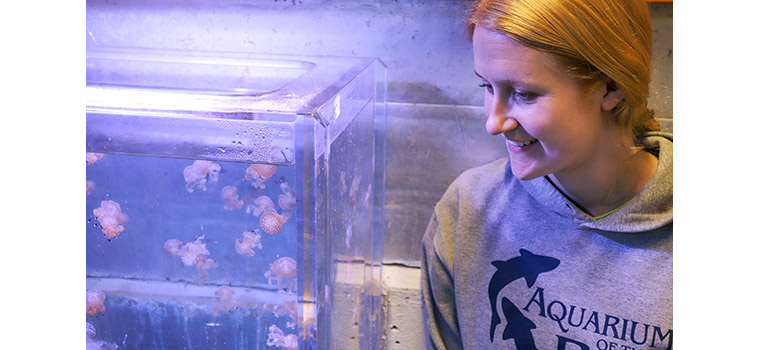The Aquarium of the Bay recently received 80 captive-bred juvenile white spotted jellies, Phyllorhiza punctata, and they are growing up behind the scenes.

A very popular and captivating display at the Aquarium of the Bay is the brown sea nettles or Chrysaora fuscescens. These jellies are commonly found just outside the Golden Gate Bridge and out near the Farallon Islands. Photo by Brian Harris
BY NORA WEBER
Published: May, 2018
The Aquarium of the Bay recently received 80 captive-bred juvenile white spotted jellies, Phyllorhiza punctata, and they are growing up behind the scenes. The largest ones have a bell about the size of a penny at the moment, but they will grow to have bells the size of baseballs or larger. They are easily recognized by their large, semi-transparent, rounded bells covered in regularly spaced white dots and trailing tentacles that end in whitened spots.
In the ocean, these jellies can travel across oceans by adhering to the hulls of ships in the polyp stage, or they can be sucked up in the ballast water of large vessels. While native to the southwest Pacific, from Australia to Japan, this is an invasive species that has traveled as far as Hawaii, Puerto Rico, the Gulf of Mexico and Brazil.
The Aquarium of the Bay also has a large quantity of juvenile moon jellies, Aurelia aurita, that were cultured in-house to augment the current display. Moon jellies prefer temperate waters and can be found in local estuaries and harbors. Their color changes with food sources: if they eat crustaceans they turn pink or lavender, and if they eat shrimp, they will turn orange.
Moon jellies reproduce best when the water has too many nutrients—usually the result of runoff from land—and too little oxygen. While moon jellies are plentiful, plastic bags in the ocean can look like jellies to animals that depend on these creatures for food. Thousands of turtles and birds die each year after swallowing plastic that is mistaken for jellies.
The new jellies are currently the size of a marble and can grow to be the size of a dinner plate. Adult moon jellies can be seen in the Go With the Flow exhibit.
The other species of jellies on display at Aquarium of the Bay are:
• Japanese sea nettles, Chrysaora pacifica: Like other sea nettles, these jellies are carnivores that thrive on consuming other jellies as well as small fishes, copepods, larvae and other zooplankton.
• Brown sea nettles, Chrysaora fuscescens: These jellies are commonly found just outside the Golden Gate Bridge and out near the Farallon Islands.
• Cassiopea Jellies, Cassiopeia xamachana: These creatures spend their lives upside down resting their bells on the sea floor. They have a symbiotic relationship with algae that live in their tissues. The algae can photosynthesize because these jellies lay with their tentacles facing upwards, and the jelly lives off the food the algae produces, as well as other food items.
Jellies have been around since at least 500 million years – a long time before dinosaurs walked the earth. They are 95 percent water, move with the current and have no heart, brain or lungs. They are food for animals such as sea turtles and mola molas—and they are an indicator of ocean health. You can float by the Aquarium of the Bay and check them out if you’d like.
Nora Weber is the Director of Marketing and Communications for Bay.org/Bay Ecotarium, a trusted not-for-profit advocacy organization with the mission to protect, restore, and inspire water conservation from the Sierra to the sea. Aquarium of the Bay is one of six institutions under the banner of Bay Ecotarium.

The largest white spotted jellies have a bell about the size of a penny at the moment, but they will grow to have bells the size of baseballs or larger. Photo by Brian Harris

